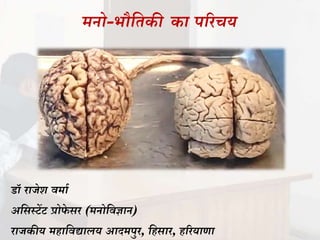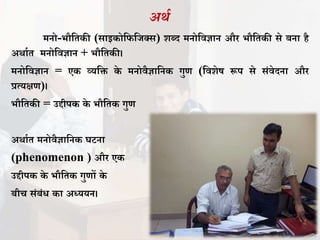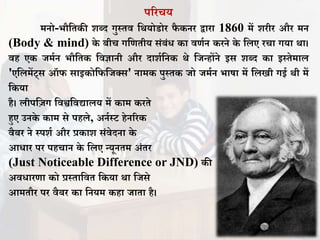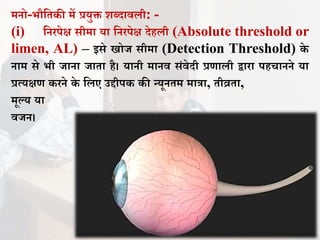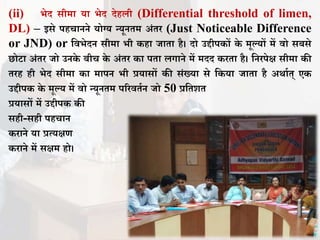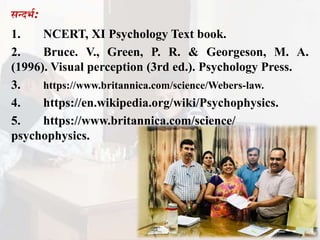मनो-भौतिकी का परिचय (Hindi)
- 1. मनो-भौतिकी का परिचय डॉ िाजेश वमाा अतिस्टेंट प्रोफे िि (मनोतवज्ञान) िाजकीय महातवद्यालय आदमपुि, तहिाि, हरियाणा
- 2. अर्ा मनो-भौतिकी (साइकोतितिक्स) शब्द मनोतिज्ञान और भौतिकी से बना है अर्ााि मनोतिज्ञान + भौतिकी। मनोतिज्ञान = एक व्यति के मनोिैज्ञातनक गुण (तिशेष रूप से संिेदना और प्रत्यक्षण)। भौतिकी = उद्दीपक के भौतिक गुण अर्ााि मनोिैज्ञातनक घटना (phenomenon ) और एक उद्दीपक के भौतिक गुणों के बीच संबंध का अध्ययन।
- 3. परिभाषा मनोतवज्ञान की वो शाखा जो एक मनोवैज्ञातनक घटना औि एक उद्दीपक के भौतिक गुणों के बीच िंबंध का अध्ययन कििी है। उद्दीपकों औि उनिे उत्पन्न होने वाली िंवेदनाओं के बीच िंबंध का अध्ययन किने वाली तवद्याशाखा को मनो-भौतिकी कहा जािा है (NCERT, XI)। "एक व्यति के अनुभव या व्यवहाि पि तकिी उद्दीपक के एक या उििे अतधक भौतिक आयामों पि उिके गुणों में व्यवतस्र्ि रूप िे परिविान के प्रभाव के अध्ययन द्वािा प्रत्यक्षणात्मक प्रतियाओं का तवश्लेषण " (Bruce et. Al 1996 quoted by Wikipedia)।
- 4. पररचय मनो-भौतिकी शब्द गुस्िि तर्योडोर िै कनर द्वारा 1860 में शरीर और मन (Body & mind) के बीच गतणिीय संबंध का िणान करने के तिए रचा गया र्ा। िह एक िमान भौतिक तिज्ञानी और दाशातनक र्े तिन्होंने इस शब्द का इस्िेमाि 'एतिमेंट्स ऑि साइकोतितिक्स' नामक पुस्िक िो िमान भाषा में तिखी गई र्ी में तकया है। िीपत़िग तिश्वतिद्यािय में काम करिे हुए उनके काम से पहिे, अनास्ट हेनररक िैबर ने स्पशा और प्रकाश संिेदना के आधार पर पहचान के तिए न्यूनिम अंिर (Just Noticeable Difference or JND) की अिधारणा को प्रस्िातिि तकया र्ा तिसे आमिौर पर िैबर का तनयम कहा िािा है।
- 5. यह तनयम बिािा है तक पहचान के तिए न्यूनिम अंिर (Just Noticeable Difference or JND) उत्पन्न करने के तिए आिश्यक पररमाण (required amount) मूि उद्दीपक या संदभा िीव्रिा के मूल्य का एक तनरंिर अनुपाि होिा है। आधुतनक मनो-भौतिकी की अिधारणा िैबर और िै कनर के काम पर आधाररि है। मनो-भौतिकी में पांच इंतियों को सतिय करने िािे उद्दीपकों की िीव्रिा तनष्पक्ष (िस्िुतनष्ठ) रूप से मापी एिं तनधााररि की िािी है।
- 6. मनो-भौतिकी में प्रयुि शब्दाििी: - (i) तनरपेक्ष सीमा या तनरपेक्ष देहिी (Absolute threshold or limen, AL) – इसे खोि सीमा (Detection Threshold) के नाम से भी िाना िािा है। यानी मानि संिेदी प्रणािी द्वारा पहचानने या प्रत्यक्षण करने के तिए उद्दीपक की न्यूनिम मात्रा, िीव्रिा, मूल्य या ििन।
- 7. तनरपेक्ष सीमा तितभन्न मनो-शारीररक दशाओं और तस्र्तिगि कारकों के आधार पर व्यतियों और तस्र्तियों में तभन्न-तभन्न होिी है। इसतिए तनरपेक्ष सीमा को मापने के तिए प्रयासों की संख्या आधार बनिी है। िब कु ि प्रयासों में से 50 प्रतिशि बार उद्दीपक को सही-सही पहचाना या प्रत्यक्षण तकया िािा है, िो उद्दीपक की उस तिशेष िीव्रिा या मूल्य को तनरपेक्ष सीमा कहा िािा है।
- 8. (ii) भेद सीमा या भेद देहिी (Differential threshold of limen, DL) – इसे पहचानने योग्य न्यूनिम अंिर (Just Noticeable Difference or JND) or तिभेदन सीमा भी कहा िािा है। दो उद्दीपकों के मूल्यों में िो सबसे छोटा अंिर िो उनके बीच के अंिर का पिा िगाने में मदद करिा है। तनरपेक्ष सीमा की िरह ही भेद सीमा का मापन भी प्रयासों की संख्या से तकया िािा है अर्ााि् एक उद्दीपक के मूल्य में िो न्यूनिम पररििान िो 50 प्रतिशि प्रयासों में उद्दीपक की सही-सही पहचान कराने या प्रत्यक्षण कराने में सक्षम हो।
- 9. मनो-भौतिकी की तितधयां उद्दीपक और प्रत्यक्षण की िीव्रिा के बीच संबंध को मापने के तिए िै कनर ने िीन महत्िपूणा तितधयों का तिकास तकया: - (i) सीमा तितध (Method of Limits) (ii) सिि उद्दीपक तितध (Method of Constant stimuli)
- 10. (iii) समायोिन तितध (Method of Adjustment) इन तितधयों का उपयोग उद्दीपक की िीव्रिा की उस दहिीि को मापने के तिए तकया िािा है िो इसका प्रत्यक्षण करने के तिए आिश्यक होिी हैं तिसे तनरपेक्ष सीमा या तनरपेक्ष देहिी के नाम से िाना िािा है।
- 11. िन्दभा: 1. NCERT, XI Psychology Text book. 2. Bruce. V., Green, P. R. & Georgeson, M. A. (1996). Visual perception (3rd ed.). Psychology Press. 3. https://www.britannica.com/science/Webers-law. 4. https://en.wikipedia.org/wiki/Psychophysics. 5. https://www.britannica.com/science/ psychophysics.
- 13. धन्यवाद तफि तमलेंगे अगली वीतडयो के िार् vermasujit@yahoo.com

